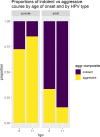Age at diagnosis, but not HPV type, is strongly associated with clinical course in recurrent respiratory papillomatosis
- PMID: 31194767
- PMCID: PMC6563955
- DOI: 10.1371/journal.pone.0216697
Age at diagnosis, but not HPV type, is strongly associated with clinical course in recurrent respiratory papillomatosis
Abstract
Background: Recurrent Respiratory Papillomatosis (RRP) is a rare disease characterized by the growth of papillomas in the airway and especially the larynx. The clinical course is highly variable among individuals and there is poor understanding of the factors that drive an aggressive vs an indolent course.
Methods: A convenience cohort of 339 affected subjects with papillomas positive for only HPV6 or HPV11 and clinical course data available for 1 year or more, from a large multicenter international study were included. Exploratory data analysis was conducted followed by inferential analyses with frequentist and Bayesian statistics.
Results: We examined 339 subjects: 82% were diagnosed prior to the age of 18 years, 65% were infected with HPV6, and 69% had an aggressive clinical course. When comparing age at diagnosis with clinical course, the probability of aggressiveness is high for children under five years of age then drops rapidly. For patients diagnosed after the age of 10 years, an indolent course is more common. After accounting for confounding between HPV11 and young age, HPV type was minimally associated with aggressiveness. Fast and Frugal Trees (FFTs) were utilized to determine which algorithms yield the highest accuracy to classify patients as having an indolent or aggressive clinical course and consistently created a branch for diagnostic age at ~5 years old. There was no reliable strong association between clinical course and socioeconomic or parental factors.
Conclusion: In the largest cohort of its type, we have identified a critical age at diagnosis which demarcates a more aggressive from less aggressive clinical course.
Conflict of interest statement
The authors have declared that no competing interests exist.
Figures



References
-
- Cuello G, Sánchez GI, Jaramillo R, Quintero K, Baena A, O’Byrne A, et al. Clinical characteristics and HPV type in recurrent respiratory papillomatosis in Colombia. Salud Publica Mex. 2013;55: 416–420. - PubMed
Publication types
MeSH terms
Supplementary concepts
Grants and funding
LinkOut - more resources
Full Text Sources

